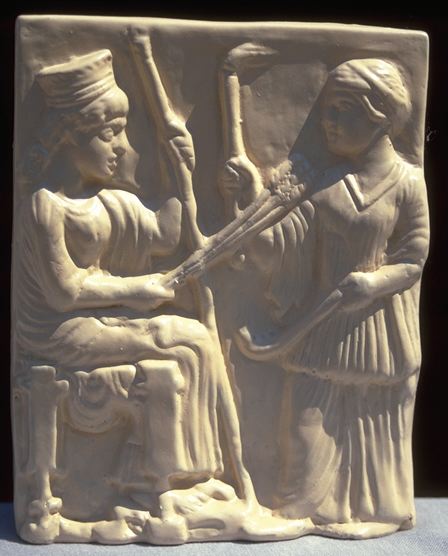Summary: Persephone is the ancient Greek Goddess of springtime.
- names
- basic information
- relations
- magick
- symbol
- candle color
- herbs
- stones
- myths
- ritual
- holy days
- priests/priestesses
- links
- titles
names:
Greek name: Persephone
Roman name: Proserpina
(NOTE: In addition to native variations by locality or over time, there are often several possible transliterations into the Roman alphabet used for English.)
basic information:
Persephone: Greek Goddess of spring and rebirth. Queen of the Underworld. Goddess of wisdom. Goddess of innocence.
Persephone is depicted as a beautiful girl on the verge of womanhood..
Persephone’s relations:
Persephone’s mother is Demeter.
Persephone’s father is Zeus.
Persephone was considered to be the same Goddess as the Roman Proserpina.
The major surviving site of Persphone worship is the Nekromanteion or Necromanteion (meaning “Oracle of Death”). This ancient temple to Hades and Persephone located on the banks of the Acheron river in Epirus, near the ancient city of Ephyra. The Greeks believed that the temple was the doorway to Hades (realm of the dead) and that the cave system under the temple was the meeting point of the Acheron (“joyless”), Pyriphlegethon (“burning coals”) and Cocytus (“lament”) rivers, which flowed through Hades. Those seeking to contact the dead would visit the temple, eat a meal of broad beans, pork, barley bread, oysters, and a narcotic compound, go through a cleansing ritual, sacrifice a sheep, and descend into the cave system. The nekyomanteia would pose a series of questions and chant prayers and the celebrants would then witness the priest arise from the floor and begin to fly about the temple through the use of Aeorema-like theatrical cranes. The architectural structure of the Mancy helped the psychosomatic process .The condominium had two levels,the upper one for the world of the living and the lower one for the world of the dead, where the dark Temple of Adis was built, the room where the pilgrims could “meet” the souls of the dead. The twisting corridor (the “road” to Adis) increased the vertigo, causing a more intense experience for the believer. At the end of the corridors, the believer had to cross the three Iron Gates to enter the Kingdom of the Dead.
magickal information and correspondences:
Symbols: sheaf of grain , wreath of flowers, pomegranate (or pomegranate seed), narcissus, torch
Persephone is associated with spring, waterfalls, rivers, and springs
Sacred candle color: black
herbs associated with Persephone:
- daisy
- ivy
- lavender
- lily of the valley
- maidenhair fern
- mint
- narcissus
- Oriental lily
- pomegranate
- reeds
- willow tree
incense associated with Persephone:
animals associated with Persephone:
- bat
- birds that talk
- monkeys
- parrot
- ram
stones associated with Persephone:
The Greeks, Romans, and Etruscans engraved gem stones to honor and make requests of Persephone.
myths and beliefs:
Hades (god of the Underworld) tempted Persephone with a narcissus and sprung from a hole in the ground and hauled the maiden Goddess to the underworld. Hades offered all of the riches of the underworld (including gold, silver, and gems), all of which Persephone rejected. Demeter, her mother, searched for her missing daughter, abandoning her duties of fruitfulness of plants, bringing about winter. Only Artemis/Diana, Goddess of the Moon, would challenge Zeus or Hades and tell Demeter where Persephone was. By the time that Demeter arrived in the underworld, Persephone had eaten a single pomegranate seed and Hades declared that made her his wife. Zeus negotiated an agreement where Persephone spent one third of the year with Hades as Queen of the Underworld, one third of the year with Zeus as his hand-maiden, and one third of the year with Demeter, as Goddess of springtime. Some modern Wiccans associate this with a woman balancing spouse, work, and family.
See also rape of Persephone.
ritual:
Persephone can be invoked for seer-ship, spiritguides, and underworld communication.
holy days:
June: Persephone is associated with June.
July: Persephone is associated with July.
September: Persephone Kore is associated with September.
Imbolc Eve: Kore Persephone is honored on January 31st, the Wiccan and Celtic Imbolc Eve.
Lesser Eleusinian Mysteries: Kore Persephone and Demeter are honored on February 1st through February 3rd, the Greek Lesser Eleusinian Mysteries.
Feast of Our Lady of Lourdes: Persephone was originally honored at Lourdes on February 11th, the French Feast of Our Lady of Lourdes.
Proserpina’s Rise: Persephone rose from the underworld on April 3rd, the Roman Day of Proserpina’s Rise.
Festival of Cerealia: Ceres searched for her daughter Proserpina (Persephone) on April 12th through April 19th, the Roman Festival of Cerealia. Roman women enacted the search at night, roaming Roman cities with lit torches.
Wiccan Feast of Hecate: Celebrated at moonrise by torchlight on August 13th, the Wiccan Feast of Hecate, honoring Hecate, Diana, and Persephone as Goddesses of magick and Protectors of Witches.
other:
Persephone was a virgin goddess (virgin meaning unmarried). Persephone was one of three primary Kore (virgin) goddesses in the Greek religion (Hellenism), representing the three kinds of unmarried women in Greek society. Kore Persephone represented the young maiden awaiting marriage. Kore Athena represented the professional woman. Kore Artemis represented the “wild” woman (often lesbians).

Picture courtesy of JBL Statues
this reproduction was sold by Sacred Source
JBL Statues is now Sacred Source
Persephone — An archetype of healing. Like our own wounded inner child, Persephone, had been abducted into the dark Hades of her unconscious patterns and process. She was lovingly searched for and assisted by Demeter, her mentoring mother. Their annual reunion, depicted here, was celebrated by the Greeks as the Rite of Spring. Illumined by the torch of insight, Persephone has returned to the upper world; Demeter blesses her with a sheaf of grain symbolizing nurture and renewal. This image offers a powerful metaphor for the psychotherapeutic process. —picture and text © 1996 JBL Statues (now called Sacred Source), original text created by Tom Laudeman
religious title certificate

Get a beautiful certificate declaring that you are a priestess, priest, high priestess, high priest, witch, or shaman of Persephone. This is a real religious certificate meeting government standards for conducting marriages and other ceremonies.
external links:
If you follow any of the links offered on this web site, no spell begging. Especially no love spell begging.
- Persephone Goddess Symbols
- Persephone sources
- Persephone Invocation
- Persephone salad
- Theoi
- Encyclopedia Mythica
- Persephone, Greek Goddess of Innocence and Receptivity and Queen of the Underworld
- Persephone Blog
If you have a Persephone-related web page, please send the URL to Milo. Please indicate if there is a picture on your web page.
Titles
The following are some of the titles of Persephone:
- Kore (Maiden)
- the maiden of the beautiful ankles
- Queen of the Underworld













